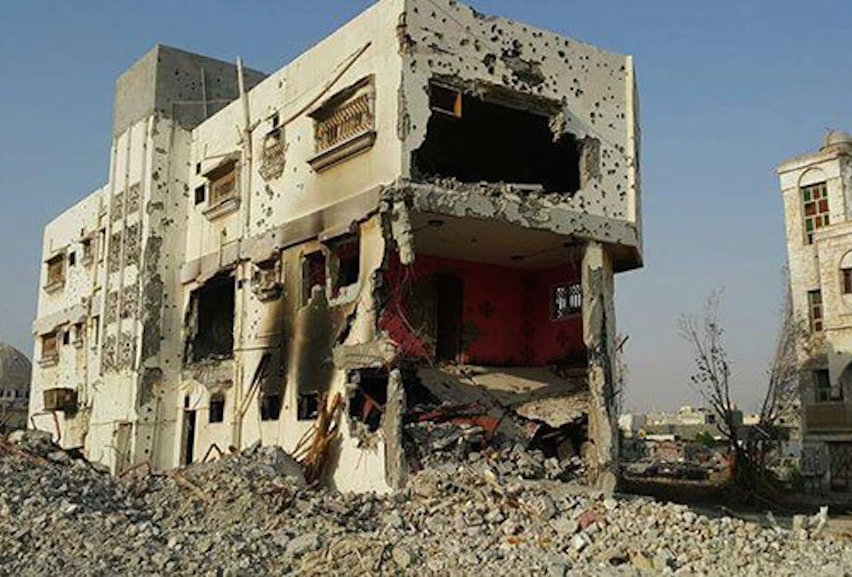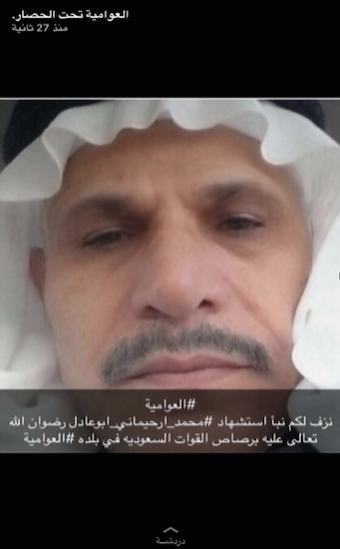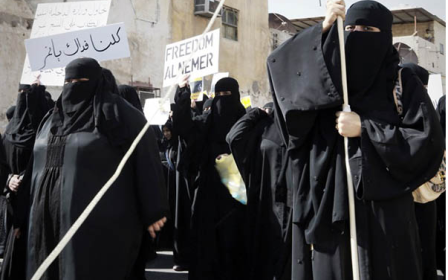Three-year-old boy dies amid siege of Saudi Shia town

A three-year-old boy died from gunshot wounds after almost two months in hospital in the restive eastern Saudi town of Awamiya.
Sajaad Mohamed Abu Abdallah is the latest victim of a months-long "siege" against the Qatif town by the Saudi government, which has seen dozens killed in clashes between Shia militants and Saudi soldiers.
According to activist accounts, Sajaad was hit on 12 June in his family car when an armoured vehicle shot live ammunition as it drove by the Awamiya Police Station. About 30 people were wounded in the attack.
He died in the Dammam Maternity and Children’s Hospital on Wednesday.
| |
Saudi Arabian forces have clashed with gunmen for more than two months in the 30,000-strong Shia town. Fighting intensified over the last past two weeks, when elite forces entered the town.
One Awamiya local, speaking anonymously to Middle East Eye, said he was living in fear and had sent his family away from the town.
"I am still in my house in Awamiya but my wife and children are away for fear of the bullets and shells of the security forces in these chaotic conditions," he said.
"This is what the residents of Awamiya have been going through since May 10."
He added that corpses could "be found everywhere in the streets".
Local residents told Reuters that three policemen and nine civilians had been killed in the recent clashes.
The pro-government al-Sharq al-Awsat news site said on Monday that two men from a list of 23 "terrorists" issued by the Saudi interior ministry had turned themselves in.
The two men, identified as Ramzi M al-Jammal and Ali H al-Zaid, voluntarily reported themselves to the authorities.
Another, Mohammed Isa al-Lubbad, turned himself in 18 days earlier.
The site said that of the 23 listed, eight had already turned themselves in, while most of the rest had been killed. Three remained at large.
Though the death toll is hard to verify, this would appear to indicate that as many as 25 people have been killed, in addition to Sajaad's death.
Sophie Baggott, policy and research associate at the Bahrain Institute for Rights and Democracy, said in a statement that the death of the child should prompt an "investigation".
"Saudi Arabia’s failure to even acknowledge the fatal shooting of civilians shows contempt for the victims and provides the security forces with impunity," she said.
Safety 'not guaranteed'
Awamiya has long been a flashpoint for protests by Saudi's Shia minority - the influential cleric Nimr al-Nimr, who was executed by the Saudi government in 2016, came from the town.
Tensions have flared in the city over reported plans to demolish and renovate the historic district Almosara, which the government said was being used by armed gunmen and had become "a haven for terrorists and suspicious activities ranging from terrorism and kidnapping to selling drugs and weapons," according to a statement released on 8 August.
Locals estimate that as many as 20,000 people have fled to towns and villages nearby since the violence began.
"After the recent escalation and the Special Security Forces’ attack on Awamiya, getting out of the house has become extremely risky, since they were ready to shoot everything that moved in the streets," said the Awamiya resident.
"After they shoot a target, the deceitful Saudi media dub him a terrorist."
He told MEE that the Saudi forces had killed a member of a committee set up to organise the evacuation of civilians from the town, who he identified as Mohammad Erhimani. He said that the function of the committee had been to coordinate with Saudi authorities the evacuation of Awamiya civilians who were told to wave white flags, a gesture the resident described as designed to "humiliate" them.
"While he was driving the bus, which had the Saudi national flag on top of it, in order to evacuate some sick and elderly people and those who had no means of transport, the Saudi authorities targeted him and killed him and also injured another volunteer who was accompanying him on the bus," he said.
"Safety under this authority is not guaranteed, for it guarantees nothing but death instead."
MEE cannot independently verify the death of Erhimani.
| |
According to an activist with sources in the wider province of Qatif, workers on farms in al-Ramis, to the northeast of Awamiya, received voice messages last week asking them to take their animals out of the area.
There have also been requisition notices attached to houses in the district of al-Shweikah, about 6km south of Almosara, issued by the Alibrahim private property development company, which is also responsible for the renovation of Almosara.
Authorities say they will replace Almosara with an attractive district of shopping centres, office buildings, green spaces and fountains.
Ameen Nemer, a former resident of the town, told MEE he feared the Saudi government was preparing to widen its offensive on the Shia-majority region, saying "they don't want a living thing in Awamiya".
The battle for Qatif
Confirming precise details about the situation in Qatif has long been difficult amid tight controls over media scrutiny imposed by the Saudi authorities.
Reuters reported earlier this year that foreign media could visit the area only if accompanied by government officials, purportedly for safety reasons.
Information has largely come from either Saudi government press releases, local activists, or Shia-focused news sites.
Journalists on a rare government tour of the town on Wednesday described the streets of the town as a "war zone".
Rusted-out cars lay half-flattened next to eviscerated homes pocked with hundreds of bullet holes, Reuters reported.
Crudely photocopied portraits of "martyrs" - one apparently 16 years old - were tacked on streetlight posts and the walls of buildings still standing.
"The land that is mixed with the blood of martyrs gets sufficiently watered by God's light to defeat the mighty," read graffiti along one rubble-strewn street.
Local activists accuse security forces of driving residents out of Awamiya by firing randomly towards homes and cars as they confront armed men in the area, a charge Saudi Arabia denies.
They said several houses and shops have been burned or damaged by the fighting. Electricity has been shut down in much of the city and private generators have been damaged, while water, fire services and waste collection have been cut off.
The lack of services has led to local community volunteer groups collecting rubbish themselves:
Andrew Hammond, a consultant on Middle East politics, said that the emptying of Awamiya could be part of a strategy to enact demographic change in the disruptive Shia region of Saudi Arabia.
"It fits that pattern," he told MEE. "It's something that's happened in the Gulf, in Bahrain, it's something that's happened outside the Gulf in Israel/Palestine.
"I think it would make sense to analyse it in that way."
He added that the fighting also worked as a "useful diversion" from the political unrest in the Saudi palace after the supplanting of former crown prince Mohammed bin Nayef with the current king's youthful son Mohammed bin Salman.
"That's been more complex than I think they would have hoped for - I think there's been some resistance to it, there's nervousness about how much irritation there is with what happened to the extent that [bin Nayef] didn't leave the country in recent weeks, when he was meant to leave the country," he said.
"So I think there's this political tension in the country at the moment, and it's always this fight with the Shia that functions usefully for them in that sense."
Middle East Eye propose une couverture et une analyse indépendantes et incomparables du Moyen-Orient, de l’Afrique du Nord et d’autres régions du monde. Pour en savoir plus sur la reprise de ce contenu et les frais qui s’appliquent, veuillez remplir ce formulaire [en anglais]. Pour en savoir plus sur MEE, cliquez ici [en anglais].






